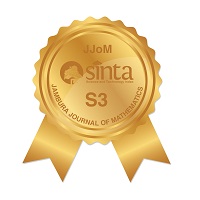Backwards Stepwise Binary Logistic Regression for Determination Population Growth Rate Factor in Java Island
Abstract
Keywords
Full Text:
PDFReferences
R. Kurniawan and S. Managi, "Economic Growth and Sustainable Development in Indonesia: An Assessment" Bulletin of Indonesian Economic Studies, vol. 54, no. 3, pp. 339-361, sep 2018, doi: http://dx.doi.org/10.1080/00074918.2018.1450962.
J. Pegou Sibe, C. Chiatchoua, and M. Noel Megne, "The long run relationship between population growth and economic growth: a panel data analysis of 30 of the most populated countries of the world" Ana´lisis Econo´mico, vol. 31, no. 77, pp. 205-218, 2016.
M. Cruz and S. A. Ahmed, "On the impact of demographic change on economic growth and poverty" World Development, vol. 105, pp. 95-106, may 2018, doi: http://dx.doi.org/10.1016/j.worlddev.2017.12.018.
R. Efendi, S. Indartono, and S. Sukidjo, "The Relationship of Indonesia's Poverty Rate Based on Economic Growth, Health, and Education" International Journal of Multicultural and Multireligious Understanding, vol. 6, no. 2, pp. 323-330, may 2019, doi: http://dx.doi.org/10.18415/ijmmu.v6i2.704.
R. F. Putri, S. Wibirama, S. R. Giyarsih, A. Pradana, and Y. Kusmiati, "Landuse change monitoring and population density analysis of Penjaringan, Cengkareng, and Cakung Urban Area in Jakarta Province" E3S Web of Conferences, vol. 76, p. 03004, jan 2019, doi: http://dx.doi.org/10.1051/e3sconf/20197603004.
F. A. Kurnianto, D. Rakhmasari, F. A. Ikhsan, B. Apriyanto, and E. A. Nurdin, "The environment analysis of population growth, unemployment, and poverty level in Maesan District Bondowoso Regency" Geosfera Indonesia, vol. 3, no. 2, pp. 113-121, aug 2018, doi: http://dx.doi.org/10.19184/geosi.v3i2.8439.
BPS, "Badan Pusat Statistik."
T. Zulkarnain, Y. Hazmi, M. Nasir, F. Faisal, and D. Husin, "Dynamic Response of Dependency Ratio on Government Expenditures in Indonesia" J. Asian Financ. Econ. Bus., vol. 9, no. 2, pp. 71-79, 2022.
M. van Smeden, K. G. Moons, J. A. de Groot, G. S. Collins, D. G. Altman, M. J. Eijkemans, and J. B. Reitsma, "Sample size for binary logistic prediction models: Beyond events per variable criteria" Statistical Methods in Medical Research, vol. 28, no. 8, pp. 2455-2474, aug 2019, doi: http://dx.doi.org/10.1177/0962280218784726.
P. Ranganathan, C. S. Pramesh, and R. Aggarwal, "Common pitfalls in statistical analysis: logistic regression" Perspect. Clin. Res., vol. 8, no. 3, pp. 148-151, 2017, doi: http://dx.doi. org/10.4103/picr.PICR 87 17.
R. Malarvizhi and A. S. Thanamani, "K-nearest neighbor in missing data imputation" Int. J. Eng. Res. Dev., vol. 5, no. 1, pp. 5-7, 2012.
K. T. Do, S. Wahl, J. Raffler, S. Molnos, M. Laimighofer, J. Adamski, K. Suhre, K. Strauch,
A. Peters, C. Gieger, C. Langenberg, I. D. Stewart, F. J. Theis, H. Grallert, G. Kastenmu¨ ller, and J. Krumsiek, "Characterization of missing values in untargeted MS-based metabolomics data and evaluation of missing data handling strategies" Metabolomics, vol. 14, no. 10, p. 128, oct 2018, doi: http://dx.doi.org/10.1007/s11306-018-1420-2.
A. Ra´cz, D. Bajusz, and K. He´berger, "Effect of Dataset Size and Train/Test Split Ratios in QSAR/QSPR Multiclass Classification" Molecules, vol. 26, no. 4, p. 1111, feb 2021, doi: http://dx.doi.org/10.3390/molecules26041111.
S. I. Khan and A. S. M. L. Hoque, "SICE: an improved missing data imputation technique" Journal of Big Data, vol. 7, no. 1, p. 37, dec 2020, doi: http://dx.doi.org/10.1186/ s40537-020-00313-w.
S. G. Liao, Y. Lin, D. D. Kang, D. Chandra, J. Bon, N. Kaminski, F. C. Sciurba, and G. C. Tseng, "Missing value imputation in high-dimensional phenomic data: imputable or not, and how?" BMC Bioinformatics, vol. 15, no. 1, p. 346, dec 2014, doi: http://dx.doi.org/10.1186/s12859-014-0346-6.
K. J. Archer and S. Lemeshow, "Goodness-of-fit Test for a Logistic Regression Model Fitted using Survey Sample Data" The Stata Journal: Promoting communications on statistics and Stata, vol. 6, no. 1, pp. 97-105, feb 2006, doi: http://dx.doi.org/10.1177/1536867X0600600106.
G. Nattino, M. L. Pennell, and S. Lemeshow, "Assessing the goodness of fit of logistic regression models in large samples: A modification of the Hosmer-Lemeshow test" Biometrics, vol. 76, no. 2, pp. 549-560, jun 2020, doi: http://dx.doi.org/10.1111/biom.13249.
J. D. Canary, L. Blizzard, R. P. Barry, D. W. Hosmer, and S. J. Quinn, "A comparison of the Hosmer-Lemeshow, Pigeon-Heyse, and Tsiatis goodness-of-fit tests for binary logistic regression under two grouping methods" Communications in Statistics - Simulation and Computation, vol. 46, no. 3, pp. 1871-1894, mar 2017, doi: http://dx.doi.org/10.1080/03610918.2015.1017583.
K. B. Watson, "Categorical Data Analysis" in Encyclopedia of Quality of Life and Well- Being Research. Dordrecht: Springer Netherlands, 2014, pp. 601-604, doi: http://dx.doi.org/10.1007/978-94-007-0753-5 291.
M. D´Ä±az-Pe´rez, A´ . CarrenËœo-Ortega, J.-A. Salinas-Andu´ jar, and A´ .-J. Callejo´n-Ferre, "Application of Logistic Regression Models for the Marketability of Cucumber Cultivars"
Agronomy, vol. 9, no. 1, p. 17, jan 2019, doi: http://dx.doi.org/10.3390/agronomy9010017.
B. A. L. Cengiz, E. R. Fikret, and H. Sonmez, "A review of statistical techniques for 2x2 and RxC categorical data tables in SPSS" Journal of Pediatric Sciences, vol. 1, 2009, doi: HTTP: //dx.doi.org/10.17334/jps.16629.
H.-A. Park, "An Introduction to Logistic Regression: From Basic Concepts to Interpretation with Particular Attention to Nursing Domain" Journal of Korean Academy of Nursing, vol. 43, no. 2, pp. 154-164, 2013, doi: http://dx.doi.org/10.4040/jkan.2013.43.2.154.
S. Ray and B. Bhattacharyya, "Availability in different source of irrigation in India: a statistical approach" Ecosystem, p. 109, 2015, doi: http://dx.doi.org/10.5923/c.ije.201501.16.
H. de G. Acquah, "Comparison of Akaike information criterion (AIC) and Bayesian information criterion (BIC) in selection of an asymmetric price relationship" J. Dev. Agric. Econ., vol. 2, no. 1, pp. 1-6, 2010.
D. R. Anderson, K. P. Burnham, and G. C. White, "Comparison of Akaike information criterion and consistent Akaike information criterion for model selection and statistical inference from capture-recapture studies" Journal of Applied Statistics, vol. 25, no. 2, pp. 263-282, apr 1998, doi: http://dx.doi.org/10.1080/02664769823250.
C.-S. Rau, S.-C. Wu, J.-F. Chuang, C.-Y. Huang, H.-T. Liu, P.-C. Chien, and C.-H. Hsieh, "Machine Learning Models of Survival Prediction in Trauma Patients" Journal of Clinical Medicine, vol. 8, no. 6, p. 799, jun 2019, doi: http://dx.doi.org/10.3390/jcm8060799.
S. Afiqah Muhamad Jamil, M. Asrul Affendi Abdullah, K. Sie Long, N. Fazilla Mohd Jupri, and M. Mamat, "A Stepwise Logistic Regression Analysis: An application toward Poultry Farm Data in Johor" International Journal of Engineering and Technology, vol. 7, no. 3.28, pp. 68-71, aug 2018, doi: http://dx.doi.org/10.14419/ijet.v7i3.28.20968.
DOI: https://doi.org/10.34312/jjom.v4i2.13529
Copyright (c) 2022 Khusnia Nurul Khikmah, Indahwati Indahwati, Anwar Fitrianto, Erfiani Erfiani, Reni Amelia

This work is licensed under a Creative Commons Attribution-NonCommercial 4.0 International License.
Jambura Journal of Mathematics has been indexed by
Jambura Journal of Mathematics (e-ISSN: 2656-1344) by Department of Mathematics Universitas Negeri Gorontalo is licensed under a Creative Commons Attribution-NonCommercial 4.0 International License. Powered by Public Knowledge Project OJS.
Editorial Office
Department of Mathematics, Faculty of Mathematics and Natural Science, Universitas Negeri Gorontalo
Jl. Prof. Dr. Ing. B. J. Habibie, Moutong, Tilongkabila, Kabupaten Bone Bolango, Gorontalo, Indonesia
Email: [email protected].




















